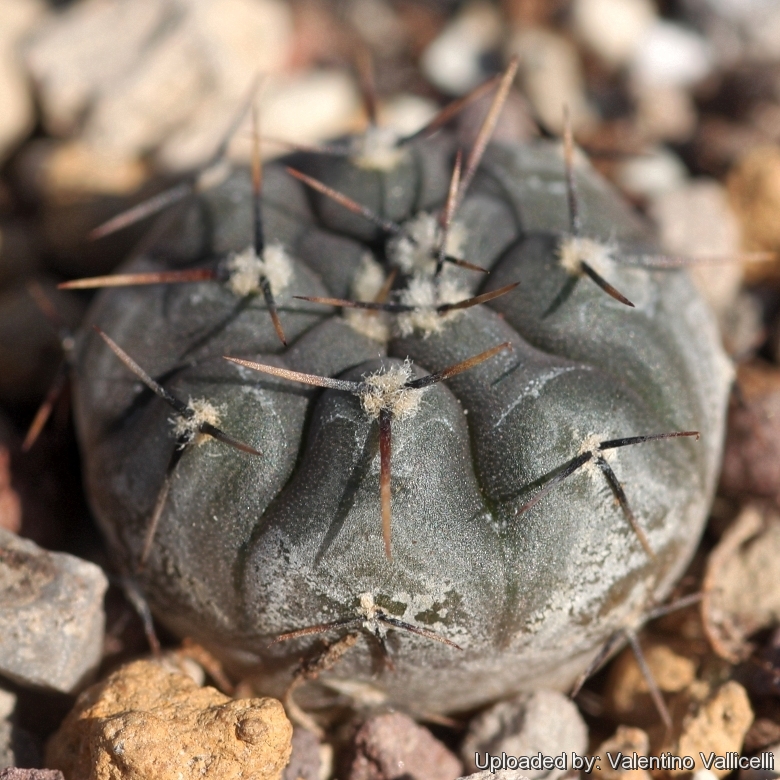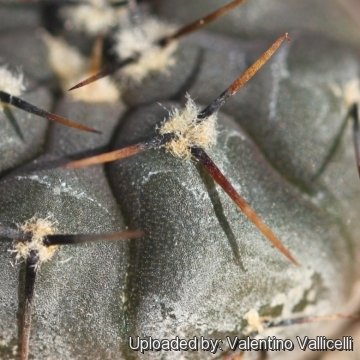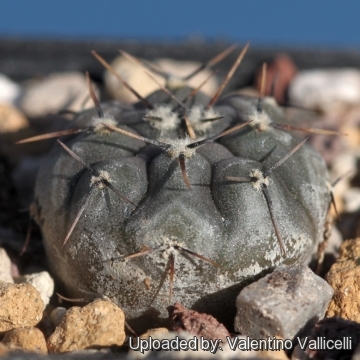
Gymnocalycium esperanzae Photo by: Valentino Vallicelli
Origin and Habitat: It occupies an area of several square kilometres in the province of La Rioja (Northwest Argentina, Southern America)
Altitude: About 500 m above sea level.
Type Locality: General San Martin Department, west of the village of Nueva Esperanza (Las Tres Marias)
Habitat: Gymnocalycium esperanzaeSN|23796]]SN|23796]] grows on low hills with shallow depressions formed by erosion in a dense shrub-land with scattered trees. the substrate is composed by gravel and loamy fine soil. This species grows mostly under the cover of lax shrubs, but also elsewhere, in direct sunlight.
Synonyms:
Description: Gymnocalycium esperanzaeSN|23796]]SN|23796]] is an attractive species with flattened stems covered with a conspicuous grey bloom.
Roots: Carrot-like unbranched or branched only apically.
Stem: 5-9(-16) cm in diameter and 5-8(-12) cm tall flattened-globose to globose epidermis greenish-brown or greenish-grey with a conspicuous grey bloom.
Ribs; (7-)9-12(-16), straight, shallow and flat in young plants becoming notched in adult specimen..
Areoles: Round to elongate, 7-15(-18) mm apart from each other, slightly sunken, with yellowish, greyish or blackish wool, almost bare with age.
Radial: 3-5(-7) if 3 in number making a T shape, if 5 or 7 in number then the upper pairs the shortest, (8-)12-18(-25) mm long brown, black, bluish-grey, pale purple or horn-coloured.
Central spines: None.
Flower:salver-shaped, (45-)55-60(-70) mm long and 35-40 mm wide; whitish-rose to pale pink, at base often pale purplish or pale rose. Style yellowish-white; stigma pale yellowish, 10-lobed. Stamens-filaments pale greenish, lower part of lower filaments slightly rose, anthers pale yellowish.
Fruit: (20-)22-30(-35) mm long and 15-18 mm wide spindle shape to clavate, greyish-green to bluish-green to pale brownish.
Seeds: Helmet-like, shiny dark maroon to blackish brown, (0,92-)1,0-1,2 mm long and 1,0-1,2(-1,3) mm wide (subgenus Microsemineum).
Notes: Some morphological traits support the hypothesis that Gymnocalycium esperanzaeSN|11483]]SN|23796]] may be a recent hybrid involving Gymnocalycium bodenbenderianumSN|14405]]SN|14405]] and Gymnocalycium castellanosiiSN|23796]]SN|11483]] subsp. armillatum, both of which occur in the surroundings.
Bibliography: Schütziana 2(2011)3 p. 2 ISSN 2191-3099 http://www.schuetziana.org/downloads/Schuetziana_2_2011_3_medium.pdf
 Gymnocalycium esperanzae Photo by: Valentino Vallicelli
Gymnocalycium esperanzae Photo by: Valentino Vallicelli Gymnocalycium esperanzae Photo by: Valentino Vallicelli
Gymnocalycium esperanzae Photo by: Valentino VallicelliCultivation and Propagation: Easy to grow, these plants offer no cultivation difficulties. Watering Needs: Moderate to copious in summer, keep dry in winter.
Frost Tolerance: Quite frost resistant if kept dry -10° C (Temperature Zone: USDA 8-10 )
Cultural Practices: Feed with a high potassium fertilizer in summer.
Sun Exposure: Full sun to light shade.
Propagation: Seeds (seldom produces offsets)












